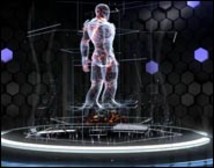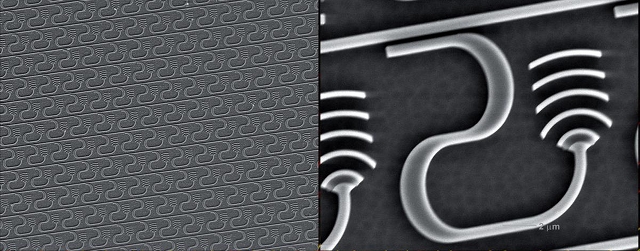/ News

Nanoscale antennas, etched in chip, provide precise control of light

A single antenna—like a single ear, eye, or audio speaker—works, but combining two or more are better. This works for sending as well as receiving. By sending the same signal from two or more identical antennas in phase with each other, you can boost it, make it extremely directional, or change its shape. This is the concept behind phased arrays, which have found great success in communications, radar, and radio astronomy.
Until now, phased arrays have mostly utilized radio frequencies. Modern nanoscale technology is now allowing researchers to create phased arrays for optical (visible) light. Jie Sun and colleagues fabricated a phased array of 4,096 microscopic antennas on a single silicon chip. This allowed them to shape the output waveform, so they could transmit an image of the MIT logo by combining the light from each tiny antenna in precise ways—something that could not be done with (say) a similar array of LEDs. Potential applications for this research include biomedical imaging, holography, and laser communications.
Phased arrays have had their greatest success at radio wavelengths, where they have been used for radar, AM radio broadcasting, and so forth. (In radio astronomy, the technique goes under the name "aperture synthesis" and led in part to a Nobel Prize for Martin Ryle and Anthony Hewish.) The idea in all these cases is the same: begin with one signal, but multiple identical antennas. By combining the output from each antenna, researchers can selectively create interference patterns, boosting the signal at distance or canceling it out entirely where it might overlap with another signal.
Radio waves have relatively large wavelengths and consequently require large antennas. This makes phased arrays that utilize radio wavelengths pricey, leading researchers to consider other portions of the electromagnetic spectrum. Although there are cheap options for working with visible light, it has the opposite problem as radio: its wavelengths are very small, and its antennas must be fabricated roughly on the same scale—400 to 700 nanometers (nm), or 0.0004 to 0.0007 millimeters.
The current experiment drew on earlier work, which created lines of nanophotonic phased arrays (NPAs) and small two-dimensional chips. The researchers fabricated a 64×64 "pixel" array of identical square antennas, each 9 microns (0.009mm) on the side. The entire array was formed out of silicon, with connecting silicon "wires" made by the same process. (The "wires" were actually waveguides, microscopic channels that shape the light passing along them in particular ways.) The researchers used a standard fabrication technique developed for complementary metal-oxide semiconductor (CMOS) chips, commonly used in consumer electronics.
Each antenna could emit across several nanometers of wavelength, allowing for multi-color transmission. A single laser fed the input to the entire NPA using a fiber optic cable. By altering the phase of the light—where the crests and troughs of the light wave occur—in the antennas, the researchers exerted tight control over the pattern that appeared at a distant detector.
Enlarge / The image of the MIT logo produced from the nanophotonic phased array (NPA). The left image is light near the NPA, while the right is the far-field image, such as might be received by a distant detector.Jie Sun
With 4,096 phased antennas packed into a square just 0.8 millimeters across, the array could do tricks unavailable to its radio-frequency cousins. To demonstrate this, the researchers controlled the emission from the NPA to generate the MIT (Massachusetts Institute of Technology) logo. That pattern is sufficiently detailed as to require many antennas to produce, so while the specific choice was somewhat irrelevant (if loyal to many of the researchers' affiliation), it demonstrated the capabilities of the array effectively.
The NPA demonstrated a powerful proof of principle, one that could have immediate application in optical systems that require tight control over the shape of light emission. Future nanoscale devices fabricated along these lines could exploit laser technology for optical-band communication, holography, medical imaging—and new uses we haven't yet conceived.
Nature, 2013. DOI: 10.1038/nature11727 (About DOIs).
Source: http://arstechnica.com/science/2013/01/nanoscale-antennas-etched-in-chip-provide-precise-control-of-light/
/ About us
Founded by Russian entrepreneur Dmitry Itskov in February 2011 with the participation of leading Russian specialists in the field of neural interfaces, robotics, artificial organs and systems.
The main goals of the 2045 Initiative: the creation and realization of a new strategy for the development of humanity which meets global civilization challenges; the creation of optimale conditions promoting the spiritual enlightenment of humanity; and the realization of a new futuristic reality based on 5 principles: high spirituality, high culture, high ethics, high science and high technologies.
The main science mega-project of the 2045 Initiative aims to create technologies enabling the transfer of a individual’s personality to a more advanced non-biological carrier, and extending life, including to the point of immortality. We devote particular attention to enabling the fullest possible dialogue between the world’s major spiritual traditions, science and society.
A large-scale transformation of humanity, comparable to some of the major spiritual and sci-tech revolutions in history, will require a new strategy. We believe this to be necessary to overcome existing crises, which threaten our planetary habitat and the continued existence of humanity as a species. With the 2045 Initiative, we hope to realize a new strategy for humanity's development, and in so doing, create a more productive, fulfilling, and satisfying future.
The "2045" team is working towards creating an international research center where leading scientists will be engaged in research and development in the fields of anthropomorphic robotics, living systems modeling and brain and consciousness modeling with the goal of transferring one’s individual consciousness to an artificial carrier and achieving cybernetic immortality.
An annual congress "The Global Future 2045" is organized by the Initiative to give platform for discussing mankind's evolutionary strategy based on technologies of cybernetic immortality as well as the possible impact of such technologies on global society, politics and economies of the future.
Future prospects of "2045" Initiative for society
2015-2020
The emergence and widespread use of affordable android "avatars" controlled by a "brain-computer" interface. Coupled with related technologies “avatars’ will give people a number of new features: ability to work in dangerous environments, perform rescue operations, travel in extreme situations etc.
Avatar components will be used in medicine for the rehabilitation of fully or partially disabled patients giving them prosthetic limbs or recover lost senses.
2020-2025
Creation of an autonomous life-support system for the human brain linked to a robot, ‘avatar’, will save people whose body is completely worn out or irreversibly damaged. Any patient with an intact brain will be able to return to a fully functioning bodily life. Such technologies will greatly enlarge the possibility of hybrid bio-electronic devices, thus creating a new IT revolution and will make all kinds of superimpositions of electronic and biological systems possible.
2030-2035
Creation of a computer model of the brain and human consciousness with the subsequent development of means to transfer individual consciousness onto an artificial carrier. This development will profoundly change the world, it will not only give everyone the possibility of cybernetic immortality but will also create a friendly artificial intelligence, expand human capabilities and provide opportunities for ordinary people to restore or modify their own brain multiple times. The final result at this stage can be a real revolution in the understanding of human nature that will completely change the human and technical prospects for humanity.
2045
This is the time when substance-independent minds will receive new bodies with capacities far exceeding those of ordinary humans. A new era for humanity will arrive! Changes will occur in all spheres of human activity – energy generation, transportation, politics, medicine, psychology, sciences, and so on.
Today it is hard to imagine a future when bodies consisting of nanorobots will become affordable and capable of taking any form. It is also hard to imagine body holograms featuring controlled matter. One thing is clear however: humanity, for the first time in its history, will make a fully managed evolutionary transition and eventually become a new species. Moreover, prerequisites for a large-scale expansion into outer space will be created as well.
Key elements of the project in the future
• International social movement
• social network immortal.me
• charitable foundation "Global Future 2045" (Foundation 2045)
• scientific research centre "Immortality"
• business incubator
• University of "Immortality"
• annual award for contribution to the realization of the project of "Immortality”.




 LinkedIn
LinkedIn
 LiveJournal
LiveJournal
 Google
Google
 Twitter
Twitter
 Facebook
Facebook
 Я.ру
Я.ру
 ВКонтакте
ВКонтакте
 Mail.ru
Mail.ru